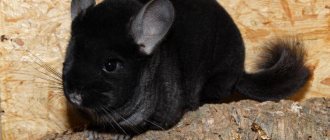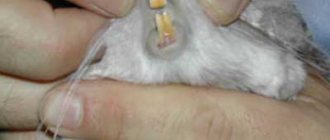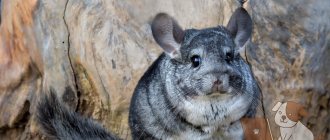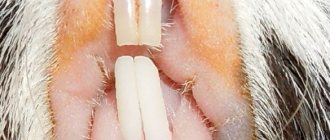In order to maintain the health, appearance and mood of the animal in good condition, constant care for this unique animal is necessary. Care consists not only of proper nutrition and providing the pet with a spacious home, but also of keeping the chinchilla’s dense, thick fur clean, helping the animal to bathe on time. This animal should be bathed in a special way, which is quite different from the usual bathing of cats or dogs.
Like any animal, a chinchilla needs to have its fur cleaned occasionally.
Answer: Itchy ears
Today I searched on the Internet for ear diseases in chinchillas. The only thing that is there is this: “As a result of severe pollution, inflammation of the external auditory canal can begin - otitis externa. Animals scratch their ears or rub their heads on the bottom of the cage. In severe cases, they keep their head tilted to the side. Brownish pus leaks from the ear canal, and in severe cases, this can lead to inflammation of the surrounding skin. The inflamed ear canal should be thoroughly cleaned with a cotton swab. However, under no circumstances should you use solvents containing alcohol, which are sold as so-called “ear cleaning solutions” and can further damage the epithelium of the ear canal. After thoroughly cleansing the ear canal, apply an ointment with fish oil and zinc using a cotton swab. After 48 hours, the ear canal is cleaned again and ointment with fish oil and zinc is applied.” I also read that ear mites do not occur in shinshas. That is, supposedly option 1 remains - that same otitis externa. But I couldn’t find anywhere where to get this ointment (with zinc and fish oil) and what to use to wipe it with (if you can’t use alcohol-containing solutions). Maybe someone knows what ointments this otitis media is treated with?
- 10.09.2007, 20:42
#6
Fur and skin glands
The fur of chinchillas, which led these animals to almost complete extermination, is unique. It is considered the thickest in the world. There are more than 25 thousand hairs per square centimeter of skin. This fur perfectly protects the animal from temperature changes. But the absence of sweat and sebaceous glands in the skin leads to the fact that the fur of an animal that gets into the water instantly gets wet. With such a dense coat, the wet coat becomes too heavy and the animal is simply unable to stay on the surface of the water. This is the first point in the dislike of these rodents for bathing.
The second danger from wet fur is that chinchillas are very sensitive to hypothermia. Wet wool loses its properties and the animal freezes very quickly.
Urolithiasis disease
The development of urolithiasis is fraught with inflammation of the bladder in a small chinchilla. This disease is typical for adult males.
Symptoms
: the rodent begins to behave inappropriately, problems with normal urination begin. To detect pathology in a timely manner, it is advisable to take your pet to a veterinarian, who will perform a urine test and, if necessary, conduct an ultrasound examination of the bladder and kidneys.
Treatment
: if there is sand in the organs, specific therapy is prescribed, but if there are stones in the genitourinary system, their surgical removal will be required.
DIY chinchilla bathing suit
If for some reason you cannot buy a regular bathing suit at a pet store, then you can make it yourself or take improvised containers. Many people think that making a chinchilla bathing suit with your own hands is difficult, but look at the examples below and make sure that absolutely anyone can make it.
What is suitable for bathing a chinchilla in the sand:
- Bathing suit made from a plastic water bottle. Anyone can make it, you just need to cut a hole into which the chinchilla will climb. The main thing is that the bottle is transparent. This bathing suit has another advantage: you can not wash it, but simply throw it away when it’s time to change the sand and make it from a new bottle. Make sure there are no sharp edges because the chinchilla will be very active and could get hurt.
- Fishbowl. An excellent solution, besides, you can find them used on Avito for only 100-200 rubles. The glass will last a long time, and it will be easier for the chinchilla to tumble in it due to the fact that the glass is very slippery.
- Any vessel, canister with round edges, which will be slightly larger in size than your animal
- As a bathing suit, you can use a transparent container, which will be slightly larger in size than a chinchilla.
- While your chinchillas are small, you can use a regular three-liter jar. Make sure that the chinchilla can easily fit into it and that there is enough space inside. If the jar turns out to be too small, then it is better to refuse it.
How to properly wash a chinchilla with water?
Sometimes you have to resort to using water to clean the skin or individual parts of the chinchilla’s body from dirt. For example, if an animal gets its paws dirty while walking around the apartment, you can pour warm water into a bowl and wipe the contaminated areas with a damp swab or sponge.
The water should be such that it is comfortable for a person to hold his hand in it - that is, not too hot or cold. When treating with water, be careful not to wet the rodent's eyes and ears.
After washing, you should immediately wrap your pet in a warm, soft towel. To ensure that the washed chinchilla dries as quickly as possible, it is recommended to use a hair dryer. Put the device on the initial mode (the hair dryer should work quietly) and dry the fur thoroughly. This will protect the animal from hypothermia and colds.
Chinchillas bathing in the sand
For this procedure you will need a sand container and volcanic sand (dust). You can purchase a special bathtub for bathing rodents at a pet store, or use a shoebox or plastic container that can be found in every housewife's kitchen. A small layer of dust is poured onto the bottom of the container - 4–5 cm will be enough for bathing one animal.
It is very exciting to watch this procedure from the outside - the animal rolls from one side to the other, moves its paws through the sand and with all its behavior makes it clear that it likes bathing.
Video: chinchillas bathing in the sand
How often can you use sand?
The frequency of bathing chinchillas is 2-3 times a week. A bathing container with sand is placed in the cage with the animal for about half an hour. But such a schedule is acceptable if the temperature in the room where the animal is kept is in the range of +18-22°C, and the humidity is 30-40%.
In some cases, it is recommended to increase the frequency of bathing. If the room temperature is above +23°C and the humidity is above 50%, then bathing is carried out 4-5 times a week.
After each bathing, the sand must be sifted through a sieve, and a little fresh sand must be added. A complete replacement of sand in the bathing suit is carried out after 10-15 bathings.
What to do if your pet doesn't want to bathe
Two weeks after giving birth, the female is already showing the cubs by example how to bathe. In another week they will be able to bathe on their own.
There are situations when the breeder’s animal was happy to bathe, but does not want to go to a new place.
Measures to take:
- take from the breeder a tray where the smell of a rodent is preserved;
- place the container lower so that the animal does not get scared;
- leave the room while the animal is bathing;
- buy sand from another company;
Under no circumstances should a rodent be forced to remain in the bathhouse against its will. This can forever cement the negative connection between the bath and the owner in the pet’s mind.
According to the observations of breeders, a young chinchilla bathes in the sand with little desire; with age, the craving for hygienic procedures increases.
When your pet refuses to bathe, eats poorly, behaves lethargically and drowsily, you need to consult a veterinarian.
There are techniques that will help reinforce the chinchilla’s desire to swim in the sand:
- Say the word “bathe” with a gentle intonation when your pet enters the bath;
- After finishing the bath, treat him with a treat.
It will take very little time for the animal to understand the benefits of bathing and begin to do it when invited.
Why does a chinchilla need to bathe?
Bathing is necessary to cleanse the coat: dead hair and excess moisture are removed from the fur. In addition, this procedure gives the animal pleasure and helps relieve stress, and for its owners it is a very entertaining sight. After bathing, your pet's fur becomes even fluffier and airier.
It should be noted that you should never bathe an animal in water because its skin is devoid of sebaceous glands, as a result of which the fur quickly becomes wet. And even if the chinchilla had the temerity to accidentally wet its fur coat, you should immediately blot it with a soft towel and dry it with a hairdryer.
Bathing suit
To take sand, or rather dust baths, a chinchilla requires a special container - a bathing suit. If your pet bathes in an open container, sand will scatter not only throughout the cage, but also around it. Therefore, as a bathing suit, you need to choose dishes with high walls or use a container made of plastic or tin measuring 30x30x20 cm. A three-liter glass jar is also suitable for bathing purposes. Glass bathing suits are good because they make it convenient to watch your chinchilla taking a bath. In pet stores you can find various bathing suits made of plastic or ceramics (for example, a ceramic bathing suit with ears or a house-shaped design is convenient).
It is not worth keeping the bathing suit in the cage all the time, as the animals can spill and contaminate the sand.
How to bathe an animal
There is no need to bathe a chinchilla in the sand; it does it itself. The owner only needs to supply a suitable bowl of sand. Ordinary sand is not suitable; you need to buy high-quality and clean filler at a pet store. River sand may contain impurities that are unnecessary for the animal. The contents of the bath are changed regularly, preventing contamination with hair and boluses.
The animal really likes to swim. If he has no other entertainment, he will do it more often than necessary. As a result, the skin will be overdried, and this should not be allowed. The tray is not left in the cage for a long time because the rodent will start using the sand bath for the toilet. Hay, feed, filler, and wool go there. As a result, the sand becomes dangerous for swimming.
Bathing suit
A bath for a chinchilla is a prerequisite for keeping it at home. If it is not there, the animal’s fur will become dirty, lumps will begin to form and an unpleasant odor will appear.
You can swim:
- Buy
- Do it yourself
Bathing suits are sold in almost every pet store or they can be ordered from online stores like Ozon. Their cost starts from 500 rubles. The bathing suit is a plastic container, which consists of two parts: a bottom and a lid. The lid should always be removable so that you can easily change the sand in it and completely disinfect it during general cleaning.
What characteristics should a swimsuit have:
- Closed top to prevent the chinchilla from throwing sand in different directions
- Opening lid to make it easy to clean the bathing suit and change the sand in it
- Safety. The hole should be large enough so that the chinchilla does not get stuck in it, and also that it does not have sharp edges.
To take sand, or rather dust baths, a chinchilla requires a special container - a bathing suit. If your pet bathes in an open container, sand will scatter not only throughout the cage, but also around it. Therefore, as a bathing suit, you need to choose dishes with high walls or use a container made of plastic or tin measuring 30x30x20 cm. A three-liter glass jar is also suitable for bathing purposes. Glass bathing suits are good because they make it convenient to watch your chinchilla taking a bath. In pet stores you can find various bathing suits made of plastic or ceramics (for example, a ceramic bathing suit with ears or a house-shaped design is convenient).
Whether or not to keep the bathing suit in a cage is up to you. It is best to store it next to the cage and transplant the animal there so that the sand is always clean. If you don’t have time to care for your pet and constantly change it into a bathing suit, then, of course, it is better to place it in a cage so that the chinchilla bathes itself when it needs it.
Which sand to choose
In nature, chinchillas are washed using dust that was formed as a result of a volcanic eruption. Sand for bathing chinchillas is a very conventional name. It is more correct to use the term – filler. There is a large selection of this substance on sale with pricing ranging from 100 to 300 rubles. for 1 kg. (depending on production).
The following manufacturers have proven themselves best (in terms of price-quality ratio) in our market:
- Vitakraft,
- Little One,
- Mr. Alex and others
The use of ordinary sand to clean the animal's fur is contraindicated. A rough abrasive can harm your chinchilla's delicate skin. In addition, it can cause diseases associated with exposure to harmful bacteria, which swarm in large numbers in river (sea) sand. You should always take into account that in natural conditions, a chinchilla bathes in sterile volcanic ash and sedimentary rock products. They do not contain harmful bacteria and exclude any infection of the rodent.
In order to provide the most suitable conditions for a cute furry pet, manufacturers of litter, in which washing chinchillas will be most comfortable, decided not to abuse modern technologies. Famous manufacturers use only materials of natural origin. In addition, natural materials can eliminate unpleasant odors when bathing a chinchilla. This result can be obtained using sepiolite, ziolite, etc.
From the many offers it can be very difficult to choose just one. Although usually the composition of all fillers is identical, with a difference in the size of the grains of sand. Therefore, choosing the one in which the chinchilla’s bathing will be as comfortable as possible can only be done experimentally. The sand in which the animal “takes a bath” without enthusiasm should be replaced with another.
How to choose a bath for chinchillas?
The key to comfortable bathing for a chinchilla is a properly selected bath. You can purchase it at a pet store or choose a suitable container from what you have at home. The main thing is that the swimsuit has the following properties:
- It had fairly high sides that prevented sand from spilling during swimming.
- It was stable so that the animal could not turn it over.
- It had a sufficient area, the size of which would allow an adult animal to fit and rotate freely (a bathing suit that is too large will lead to excessive consumption of valuable sand).
Chinchilla in a bathing suit
An alternative to purchased baths can be:
- food containers;
- plastic canisters;
- plastic buckets;
- water bottles (5-6 l);
- three-liter glass jars.
In plastic containers, an “entrance” is cut out on the larger side, the edges of which are processed with fine sandpaper. The glass jar is simply turned over on its side before placing the animal there.
How to make sand yourself
Chinchilla owners who have several animals may find it expensive to constantly use special bathing mixtures sold in pet stores. Therefore, some people prefer to make their own sand for bathing pets. The technology for preparing such a mixture is very simple.
Components: river or quarry sand of fine fractions, talc, medical sulfur. Ordinary construction sand or sand for playgrounds, as discussed above, is strictly contraindicated.
The technological process is as follows:
- The sand is well washed and sifted;
- Then it is calcined in a frying pan or in the oven for 10-15 minutes;
- Sulfur and talc are added to the heated sand - 1-2 tbsp. spoons of each of these components.
- The resulting mass is thoroughly mixed.
FAQ
In order for your pet to enjoy bathing in the sand without damaging its fur and skin, it is necessary to pay due attention to the choice of bathing suit, sand and all additional accessories for washing the animal.
What you need to purchase for proper bathing of chinchillas
To wash your pet, you should purchase the most convenient container into which sand will be poured. This container must be, first of all, safe: without sharp corners and chips, and also easy to wash under water.
Most bathing suits come in two types: a small bath, which is placed in the animal’s house, or a separate terrarium, where the pet moves for half an hour to carry out hygiene procedures. The first option is considered the most convenient, but in this case the owner needs to clean both the bathing suit and the animal’s cage quite often. The good thing about the terrarium option is that the closed shape of the container will prevent sand from being scattered around.
List of necessary items for swimming:
- comfortable and safe swimsuit;
- special sand, for example, volcanic sand for bathing rodents;
- medical sulfur for fur disinfection. This product can be purchased at pet stores, but medical sulfur should be used less frequently: once every few months unless otherwise specified by the veterinarian;
- talc for shine and smoothness of wool.
You can choose suitable sand for washing your animal only from the assortment presented in pet stores . Ordinary river, sea, construction or any other sand will not be suitable for bathing your pet.
Choosing the right sand for chinchillas
When choosing a bulk filler for a bath, you should pay special attention to the quality and composition of the sand. Soft, safe sand will not scratch the skin of your hands, so you can check the quality of this product at home by lightly rubbing the grains with your fingers.
It is advisable to choose a product without quartz content. A good finished product, which is sold in pet stores, contains volcanic sand or related components: sepiolite, zeolite or soapstone.
The filler should absorb moisture and fat well.
DIY sand for chinchillas
Some owners prefer to use sand made by themselves. This is not difficult to do; it is only important to find a high-quality starting material - zeolite, which should be crushed into crumbs and calcined in the oven. If desired, you can add a little talc to the resulting bulk product.
Have you tried making sand yourself?
Why does a chinchilla eat sand?
Sometimes your pet will start eating sand for bathing, but there is nothing to worry about. The rodent does this to normalize the gastrointestinal tract, thus grinding food.
In some cases, this behavior may indicate that the pet does not have enough calcium. To replenish calcium, you can grind calcium tablets for rodents and give them a little at a time.
Additional ingredients for bathing sand
As additional ingredients in sand, you can use talc, which has a beneficial effect on the appearance of fur, as well as disinfectants, for example, medical sulfur. You can also use fungistop, which contains both sulfur and talc. The optimal dosage of fungistop for one standard bathing suit is 1 teaspoon.
It is highly not recommended to wash your chinchilla in water!
What to do if your chinchilla gets wet
If the pet gets wet, it should be removed from the water as soon as possible and wrapped in a towel that absorbs moisture well. The fur should be blotted regularly with a dry cloth.
All windows must be closed and air conditioners must be turned off. Any, even the slightest drafts should be avoided.
Periodically, the towel in which the animal dries needs to be replaced with a dry one.
You can try to dry the fur with a hairdryer, holding the device with warm air at a distance of 20 cm from the animal’s fur. If the animal is afraid of noise, turn off the hair dryer and dry the fur with a towel.
You should not let your pet into the cage before it is completely dry. During drying, the animal should not freeze.
Important. Chinchillas cannot swim, so staying in water for a long time is very dangerous for them.
What to do if your chinchilla doesn't want to bathe
Refusal to bathe may be a sign that the pet has not yet fully settled into the house. In this case, you need to give the animal more time to adapt. When the animal begins to carry out hygiene procedures, it should be praised for this with a piece of a healthy treat after washing.
If the animal suddenly stops using the bathing suit, this may indicate some health problems, so the chinchilla should be shown to a veterinarian.
Sometimes sand or a bathing suit is not suitable for your pet. You can try to replace the filler, as well as the washing container itself.
Important. You cannot force your pet to bathe.
Review of popular bathing mixtures
Both domestic and foreign manufacturers offer many varieties of ready-made sand mixtures for bathing chinchillas. Let's look at the most popular manufacturers of sand for bathing chinchillas.
- Benelux . The basis of this bathing mixture is zeolite; it is a well-known and trusted manufacturer. Although the price is not high, it is also difficult to call this sand budget.
- Lolopets . Composition: volcanic dust and crushed quartz. One of the advantages is the low price.
- Mr. Alex . Affordable sand for bathing chinchillas based on crushed quartz. The package also contains talc in a separate sachet, which must be added before bathing.
- Waka . Produced in Russia. Base: a mixture of volcanic sand with crushed quartz. A sachet of talcum powder is also included. Owners of chinchillas in reviews of this mixture strongly recommend that you carefully inspect it after purchase, since large particles may be encountered that can injure the animal. If such particles are found, they should be removed. As for the price, it is quite affordable.
- Little animals . Mixture from a Russian manufacturer. Chinchilla owners write in reviews that at a very affordable price, this mixture, which includes talc, magnesite and chlorite, is quite good. It perfectly cleans the animal's fur without harming it.
- Padovan . Sand from this manufacturer is recommended for use by owners of chinchillas whose animals are kept in rooms where the humidity is above average. Because this mixture, made on the basis of zeolite with the addition of a number of minerals, has excellent performance in terms of absorption and moisture retention.
- Vitacraft . Products of a famous German manufacturer of pet products. Composition: sepiolite and other minerals. The mixture is very popular due to its relatively low price and good consumer characteristics.
- Little One . Made from several minerals of volcanic origin. Chinchilla owners note that the main advantage is the almost perfect balance of components, which allows for the best possible cleaning of the animal’s fur. A very noticeable disadvantage is the high cost.
The Legend of Deadly Water
The above facts contributed to the emergence of the opinion that water is lethal for chinchillas. Actually this is not true. First of all, there is hardly an animal in nature that has never been completely wet in its life. Another confirmation is the testimony of owners who had to bathe their pets.
The main difficulty in this case is not to overcool the animal after the procedure. Even a hairdryer is not the most suitable solution for this purpose, since the air cools down quite significantly when passing through wet wool. If you still had to bathe your chinchilla in water or the animal accidentally got wet, the best solution would be to carefully wet the animal and hold it in your bosom, warming it with your warmth until it dries completely. Be prepared for the fact that you will have to serve the heating pad for a long time.
So, water itself will not kill your pet. If you exercise maximum caution, everything will end well. However, it is worth considering that the animal will be stressed during such a bath. And you will be haunted by worries: is everything okay, have you caught a cold?
Therefore, it is better not to go against nature and give your pet the opportunity to take baths in the conditions that are most suitable for him. Zeolite dust for bathing chinchillas is available in almost any pet store.
In addition to dust, it is advisable to purchase a special bathing suit. If one is not on sale, you can use a large plastic container. Make sure that the walls of your makeshift bathing suit are transparent - and you are guaranteed a charge of good mood and positive emotions!
The animal enthusiastically spins in the dust, shakes itself off, combs itself, and again performs funny pirouettes. Chinchilla bathes with great pleasure. To keep the animal's skin clean, one or two dust baths per week are enough. You should not skimp on zeolite; the particles in ordinary sand are too large and are not suitable for cleaning dense fur; moreover, it may also contain parasites.
Sand baths
Traditional baths are contraindicated for chinchillas, but sand baths are what you need. Exotic rodents love to swim not in water, but in sand. This is how they are used to cleaning their fur and maintaining hygiene.
Chinchillas “swim” in the sand with pleasure
To keep the body clean, 1-2 sand baths per week are enough for the animal. It is also convenient that the owner does not need to do anything during the bathing process - chinchillas fall out in the sand themselves with great pleasure.










